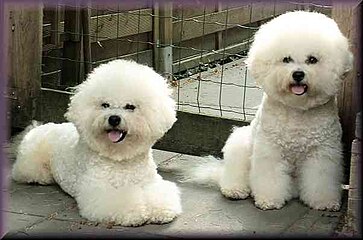Bichon Frisé
| Bichon Frisé | |||||||||||||||||||||||
|---|---|---|---|---|---|---|---|---|---|---|---|---|---|---|---|---|---|---|---|---|---|---|---|
 | |||||||||||||||||||||||
| Other names |
| ||||||||||||||||||||||
| Origin |
| ||||||||||||||||||||||
| |||||||||||||||||||||||
| |||||||||||||||||||||||
| Dog(domestic dog) | |||||||||||||||||||||||
TheBichon Frisé[a]orBichon à Poil Friséis a Franco-Belgianbreedof smalltoy dogofbichontype.It was recognised by theSociété Centrale Caninein 1933 and by theFédération Cynologique Internationalein 1959.
Etymology
[edit]TheFrenchwordbichoncomes fromMiddle Frenchbichon('small dog'), a diminutive ofOld Frenchbiche('female dog',cognatewith Englishbitch), fromOld Englishbicce,and related to otherGermanicwords with the same meaning, includingOld Norsebikkja,andGermanBetze.[1][2]Some speculate the origin ofbichonto be the result of theapheresis,or shortening, of the wordbarbichon('small poodle'), a derivative ofbarbiche('shaggy dog'); however, this is likely impossible, since the wordbichon(attested 1588) is older thanbarbichon(attested 1694).[3][4]While the English name for the breed,Bichon Frise,is derived from the Frenchbichon à poil frisémeaning 'curly haired small dog'.[5]
History
[edit]
The dogs found early success inSpainand it is generally believed that Spanish seamen introduced the early breed toTenerifein theCanary Islands.Their association with European nobility began in the 13th century, entering the royal courts of Spain, Italy and France.[7]In the 14th century, Italian sailors rediscovered the dogs on their voyages and are credited with returning them to continental Europe.[8]
The Bichon à Poil Frisé was recognised by theSociété Centrale Caninein 1933.[9]It was definitively accepted by theFédération Cynologique Internationalein October 1959.[10]
Some of the dogs were brought to the United States in 1955[11]and to the United Kingdom in 1973.[12]
Appearance
[edit]The Bichon Frisé is a small dog, standing 23–30 cm (9–12 in) at thewithersand weighing approximately 5 kg (11 lb), the weight varying in proportion to the height. The skull is rather flat, but may appear rounded; the muzzle tapers only slightly, and constitutes two-fifths of the length of the head. The nose is black, the eyes dark and round.[10]
The coat is loosely curled in spirals or corkscrews, with a thick soft undercoat. It is always pure white; only in dogs under a year old may it be slightly tinged with beige, this extending over no more than 10% of the area of the body. The head and legs are proportionate in size to the body.[13]
Health
[edit]A 2024 UK study found a life expectancy of 12.5 years for the breed compared to an average of 12.7 for purebreeds and 12 forcrossbreeds.[14]
An American study looking atimmune-mediated hemolytic anemiafound a predisposition to the condition in the Bichon Frise, with 9% of cases belonging to the breed despite being 2% of the control population.[15]
A study in the UK found the Bichon Frise to be predisposed togall bladder disease(excludinggall bladder mucocele). The Bichon Frise was found to be 9.26 times more likely to acquire a non-mucocele gall bladder disease than other dogs.[16]
-
Pet trim
-
Show cut
-
At sixteen years old
Notes
[edit]- ^/ˈbiːʃɒnˈfriːz/or/ˈbiːʃɒnfrɪˈzeɪ/;fromFrench:bichon à poil frisé,French pronunciation:[biʃɔ̃fʁize],meaning 'curly haired dog'
References
[edit]- ^Auguste Scheler,Dictionnaire d'étymologie française d'après les résultats de la science moderne,"bichon".
- ^Donkin, Diez,An etymological dictionary of the Romance languages,"biche".
- ^Centre National de Ressources Textuelles et Lexicales, "bichon".
- ^"French etymology of barbiche".myEtymology.com. Archived from the original on 14 July 2011.Retrieved10 October2012.
{{cite web}}:CS1 maint: unfit URL (link) - ^"Bichon Frise Dog Breed Information".Akc.org.Retrieved11 December2017.
- ^"María Cayetana de Silva, 13th Duchess of Alba",Art Hive,2 December 2020,retrieved8 December2020
- ^"Bichon Frise History: Time's Sociable Survivor".American Kennel Club.14 June 2021.Retrieved22 October2021.
- ^"History of the Bichon Frise".bichon.org.Archived fromthe originalon 13 April 2021.Retrieved11 July2019.
- ^"Bichon Frise Page".AKC.org.American Kennel Club.2012.Retrieved10 October2012.
- ^abFCI breeds nomenclature: Bichon à Poil Frisé (215).Thuin, Belgium: Fédération Cynologique Internationale. Accessed April 2024.
- ^"Get to Know the Bichon Frise",The American Kennel Club.Retrieved 30 April 2014.
- ^James, Elizabeth (2015).Bichon Frisé: Dog Expert.Pet Book Publishing Company Ltd. p. 22.ISBN978-1-906305-74-1.
- ^"FCI-Standard No. 215: Bichon Frisé (Bichon à poil frisé)".FCI.be.Fédération Cynologique Internationale.11 May 1998. Archived fromthe originalon 31 August 2012.Retrieved20 February2018.
- ^McMillan, Kirsten M.; Bielby, Jon; Williams, Carys L.; Upjohn, Melissa M.; Casey, Rachel A.; Christley, Robert M. (1 February 2024)."Longevity of companion dog breeds: those at risk from early death".Scientific Reports.14(1). Springer Science and Business Media LLC.doi:10.1038/s41598-023-50458-w.ISSN2045-2322.PMC10834484.
- ^Miller, Sybille A.; Hohenhaus, Ann E.; Hale, Anne S. (1 January 2004). "Case-control study of blood type, breed, sex, and bacteremia in dogs with immune-mediated hemolytic anemia".Journal of the American Veterinary Medical Association.224(2): 232–235.doi:10.2460/javma.2004.224.232.ISSN0003-1488.
- ^Bandara, Y.; Bayton, W. A.; Williams, T. L.; Scase, T.; Bexfield, N. H. (2021). "Histopathological frequency of canine hepatobiliary disease in the United Kingdom".Journal of Small Animal Practice.62(9): 730–736.doi:10.1111/jsap.13354.ISSN0022-4510.



